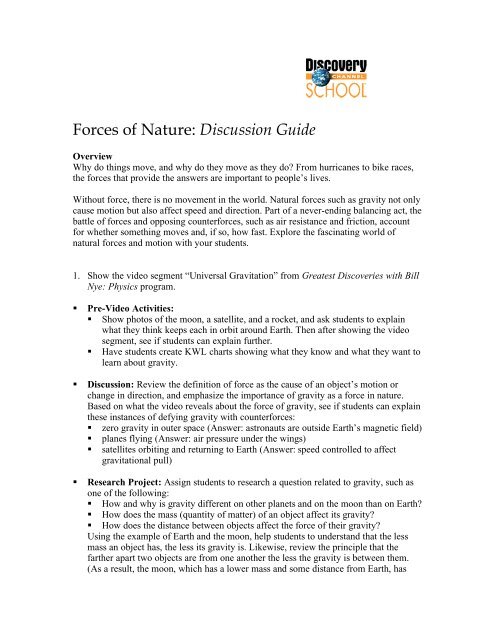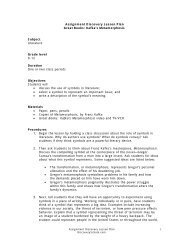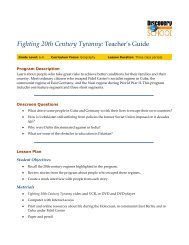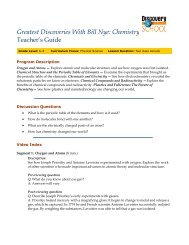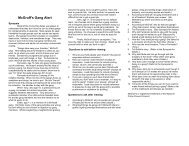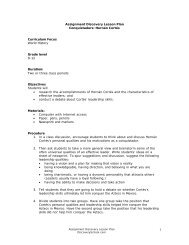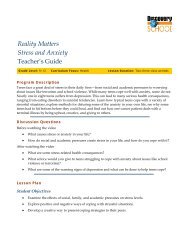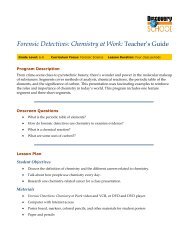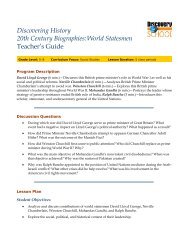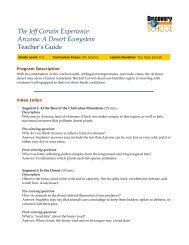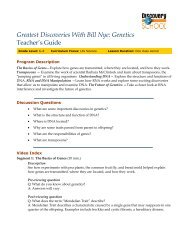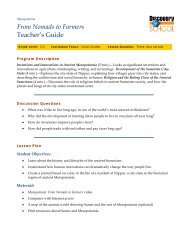Forces of Nature: Discussion Guide
Forces of Nature: Discussion Guide
Forces of Nature: Discussion Guide
Create successful ePaper yourself
Turn your PDF publications into a flip-book with our unique Google optimized e-Paper software.
<strong>Forces</strong> <strong>of</strong> <strong>Nature</strong>: <strong>Discussion</strong> <strong>Guide</strong><br />
Overview<br />
Why do things move, and why do they move as they do? From hurricanes to bike races,<br />
the forces that provide the answers are important to people’s lives.<br />
Without force, there is no movement in the world. Natural forces such as gravity not only<br />
cause motion but also affect speed and direction. Part <strong>of</strong> a never-ending balancing act, the<br />
battle <strong>of</strong> forces and opposing counterforces, such as air resistance and friction, account<br />
for whether something moves and, if so, how fast. Explore the fascinating world <strong>of</strong><br />
natural forces and motion with your students.<br />
1. Show the video segment “Universal Gravitation” from Greatest Discoveries with Bill<br />
Nye: Physics program.<br />
Pre-Video Activities:<br />
Show photos <strong>of</strong> the moon, a satellite, and a rocket, and ask students to explain<br />
what they think keeps each in orbit around Earth. Then after showing the video<br />
segment, see if students can explain further.<br />
Have students create KWL charts showing what they know and what they want to<br />
learn about gravity.<br />
<strong>Discussion</strong>: Review the definition <strong>of</strong> force as the cause <strong>of</strong> an object’s motion or<br />
change in direction, and emphasize the importance <strong>of</strong> gravity as a force in nature.<br />
Based on what the video reveals about the force <strong>of</strong> gravity, see if students can explain<br />
these instances <strong>of</strong> defying gravity with counterforces:<br />
zero gravity in outer space (Answer: astronauts are outside Earth’s magnetic field)<br />
planes flying (Answer: air pressure under the wings)<br />
satellites orbiting and returning to Earth (Answer: speed controlled to affect<br />
gravitational pull)<br />
Research Project: Assign students to research a question related to gravity, such as<br />
one <strong>of</strong> the following:<br />
How and why is gravity different on other planets and on the moon than on Earth?<br />
How does the mass (quantity <strong>of</strong> matter) <strong>of</strong> an object affect its gravity?<br />
How does the distance between objects affect the force <strong>of</strong> their gravity?<br />
Using the example <strong>of</strong> Earth and the moon, help students to understand that the less<br />
mass an object has, the less its gravity is. Likewise, review the principle that the<br />
farther apart two objects are from one another the less the gravity is between them.<br />
(As a result, the moon, which has a lower mass and some distance from Earth, has
less gravity than Earth. However, Earth is still close enough to the moon to keep it in<br />
orbit.)<br />
Biography: Introduce the following famous thinkers and scientists who had a role in<br />
explaining the force <strong>of</strong> gravity. Invite students to read a biography <strong>of</strong> one <strong>of</strong> them.<br />
Aristotle<br />
Galileo<br />
Copernicus<br />
Newton<br />
Einstein<br />
2. Show the video segment “Introduction to <strong>Forces</strong> and Gravity” from Physical Science:<br />
<strong>Forces</strong> and Gravity program. (Access to unitedstreaming is required.)<br />
Pre-Video Activity: Invite students to take the following true/false quiz before<br />
seeing the video:<br />
T F <strong>Forces</strong> in nature can speed up the motion <strong>of</strong> objects.<br />
T F <strong>Forces</strong> in nature cannot slow down the speed <strong>of</strong> objects.<br />
T F <strong>Forces</strong> in nature can change the direction <strong>of</strong> objects.<br />
T F The strength <strong>of</strong> a force is less important than the direction <strong>of</strong> the force.<br />
(Answers: T, F, T, F)<br />
Group Demonstration: After showing the video, list Newton’s three laws on the<br />
board or overhead projector, and request that students explain them. Then assign a<br />
team <strong>of</strong> students to each law to demonstrate it to the rest <strong>of</strong> the class, using objects in<br />
the classroom.<br />
1. An object at rest stays at rest and an object in motion stays in motion (inertia)<br />
unless a force acts on it.<br />
2. If a force acts on an object, the object will move.<br />
3. For every action, there is an equal and opposite reaction.<br />
<strong>Discussion</strong>: Ask students how each <strong>of</strong> the following demonstrates one or more <strong>of</strong><br />
Newton’s laws:<br />
Water spills out <strong>of</strong> a full bucket <strong>of</strong> water when a rock is dropped in it.<br />
Balancing dominoes are knocked over.<br />
A tether ball keeps going around the pole until the rope is wrapped around it.<br />
A child slides down a slide even without pushing <strong>of</strong>f from it.<br />
An ice hockey puck slides across the ice and into the net.<br />
A balloon shoots out when the air inside is released.<br />
A bowling ball knocks over ten pins.<br />
The speed <strong>of</strong> a skydiver changes once a parachute opens.<br />
Current Events: Bring a newspaper to class to see if any news stories show the<br />
effect forces <strong>of</strong> nature have on human lives. One common example is wind. Ask:<br />
How do winds, especially hurricane-force winds, affect people? Cite examples <strong>of</strong> the<br />
forces <strong>of</strong> nature causing damage, as with Hurricane Katrina that devastated New<br />
Orleans, and see if students can give scientific reasons why this occurs.
3. Show the video segment “Effects <strong>of</strong> <strong>Forces</strong> on Speed” from The Physics <strong>of</strong> Motion<br />
program. (Access to unitedstreaming is required.)<br />
Diagramming: Have students draw diagrams to show the effect <strong>of</strong> the following<br />
forces on a bicycle: air resistance, friction, gravity, and pressure.<br />
<strong>Discussion</strong>: Using a photograph or drawing <strong>of</strong> a bicycle, ask students for a scientific<br />
explanation <strong>of</strong> the following:<br />
What propels a cyclist forward? (pressure, power, inertia once started)<br />
Why do some cyclists go faster than others? (more pressure, power, lighter)<br />
What keeps a biker going at a constant speed? (balanced forces)<br />
Why do pr<strong>of</strong>essional cyclists wear sleek clothing? (to lessen air resistance)<br />
What brings cycles to a stop? (friction, air resistance)<br />
Why is a cycling track banked on the side? (Introduce students to centrifugal<br />
force, which pulls objects outward when they are circling around a center.)<br />
Ask students to draw conclusions about how forces affect speed and direction.<br />
Problem-Solving: Challenge students to design cars so that speed increases with the<br />
least force possible. Set up a long track made <strong>of</strong> sloping plywood planks, and invite<br />
students to design three-inch cars to release at the top. Using a stopwatch, compare<br />
the cars’ times. Beforehand, talk about the influence <strong>of</strong> gravity and inertia, along with<br />
the counterforces <strong>of</strong> air resistance and friction. Afterward, draw conclusions about<br />
why certain cars are faster than others.<br />
Analogies: To explain air resistance, the analogy is made to riding a bike through<br />
water. Invite students to create their own analogies to clarify the following: gravity,<br />
G-force, friction, counterforce, balanced forces.<br />
Scientific Method: Ask students to investigate the relationship between the strength<br />
<strong>of</strong> a force and its effect. Have them design a simple experiment to test their<br />
hypothesis. (For example, students might test how far a scrap <strong>of</strong> paper moves when<br />
one person blows on it versus when three people blow on it.) Students should gather<br />
data, test their hypothesis, draw conclusions, and explain their results. In general, they<br />
will find that these principles apply:<br />
the greater the force, the greater the change in motion<br />
the larger the mass, the smaller the effect <strong>of</strong> a force<br />
Cause-Effect Chart: Have students make a cause-effect chart indicating how the<br />
following overcome inertia: boat, car, person, kite, rocket, bird. Ask which is easiest<br />
to move and which is hardest to move. Explain that the greater the mass, the harder<br />
something is to move.<br />
Mathematics: Tell students that the mathematical formula for the effect <strong>of</strong> force on<br />
velocity is force = mass x acceleration. Have them solve mathematical problems<br />
using this formula.
4. Show the video segment “Coasting Through Physics” from Scientific Investigations<br />
Physical Science: Investigating Motion, <strong>Forces</strong> and Energy program. (Access to<br />
unitedstreaming is required.)<br />
Mathematics: Explain that speed (velocity) is expressed as distance over time. Invite<br />
students to solve time and distance problems such as this: If a car is traveling at 30<br />
miles per hour for the first two hours and then 50 miles per hour for three more hours,<br />
how far does it travel? (Answer: 210 miles)<br />
Glossary: Have students define the following terms on flashcards: gravity, velocity,<br />
acceleration, friction, Gs, inertia, centripetal force.<br />
<strong>Discussion</strong>: Ask: How do the forces listed above act on roller coaster passengers? On<br />
an aerobatic pilot?<br />
Experiment: Direct students to replicate Newton’s experiment with gravity to test if<br />
heavier objects drop faster. From a high place have students drop a rock and a cotton<br />
ball to see which lands first. Ask why a lighter object would be affected more by air<br />
resistance. Discuss why conducting the experiment in a vacuum would change the<br />
results.<br />
Descriptive Writing: Encourage students to ride an elevator and describe the<br />
physical sensations they experience. Then invite students to explain these sensations<br />
in terms <strong>of</strong> the forces acting upon them.<br />
Poster: Encourage students to create a poster to show one <strong>of</strong> the principles <strong>of</strong> motion<br />
they have learned.<br />
Academic Standards<br />
This discussion guide addresses the following national standards:<br />
National Science Education Standards<br />
www.nap.edu/readingroom/books/nses/html/<br />
Motions and forces<br />
Mid-continent Research for Education and Learning (McREL)<br />
http://www.mcrel.org/compendium/browse.asp<br />
Language Arts<br />
Writing: Uses the general skills and strategies <strong>of</strong> the writing process, uses the<br />
stylistic and rhetorical aspects <strong>of</strong> writing<br />
Science
Understands forces and motion:<br />
Level II (Grades 3–5):<br />
Knows that the Earth’s gravity pulls any object toward it without touching it<br />
Knows that when a force is applied to an object, the object either speeds up,<br />
slows down, or goes in a different direction<br />
Knows the relationship between the strength <strong>of</strong> a force and its effect on an<br />
object (e.g., the greater the force, the greater the change in motion; the more<br />
massive the object, the smaller the effect <strong>of</strong> a given force)<br />
Level III (Grades 6–8):<br />
Understands general concepts related to gravitational force (e.g., every object<br />
exerts gravitational force on every other object; this force depends on the mass<br />
<strong>of</strong> the objects and their distance from one another; gravitational force is hard<br />
to detect unless at least one <strong>of</strong> the objects, such as the Earth, has a lot <strong>of</strong> mass)<br />
Understands effects <strong>of</strong> balanced and unbalanced forces on an object’s motion<br />
(e.g., if more than one force acts on an object along a straight line, then the<br />
forces will reinforce or cancel one another, depending on their direction and<br />
magnitude; unbalanced forces such as friction will cause changes in the speed<br />
or direction on an object's motion)<br />
Knows that an object that is not being subjected to a force will continue to<br />
move at a constant speed and in a straight line


